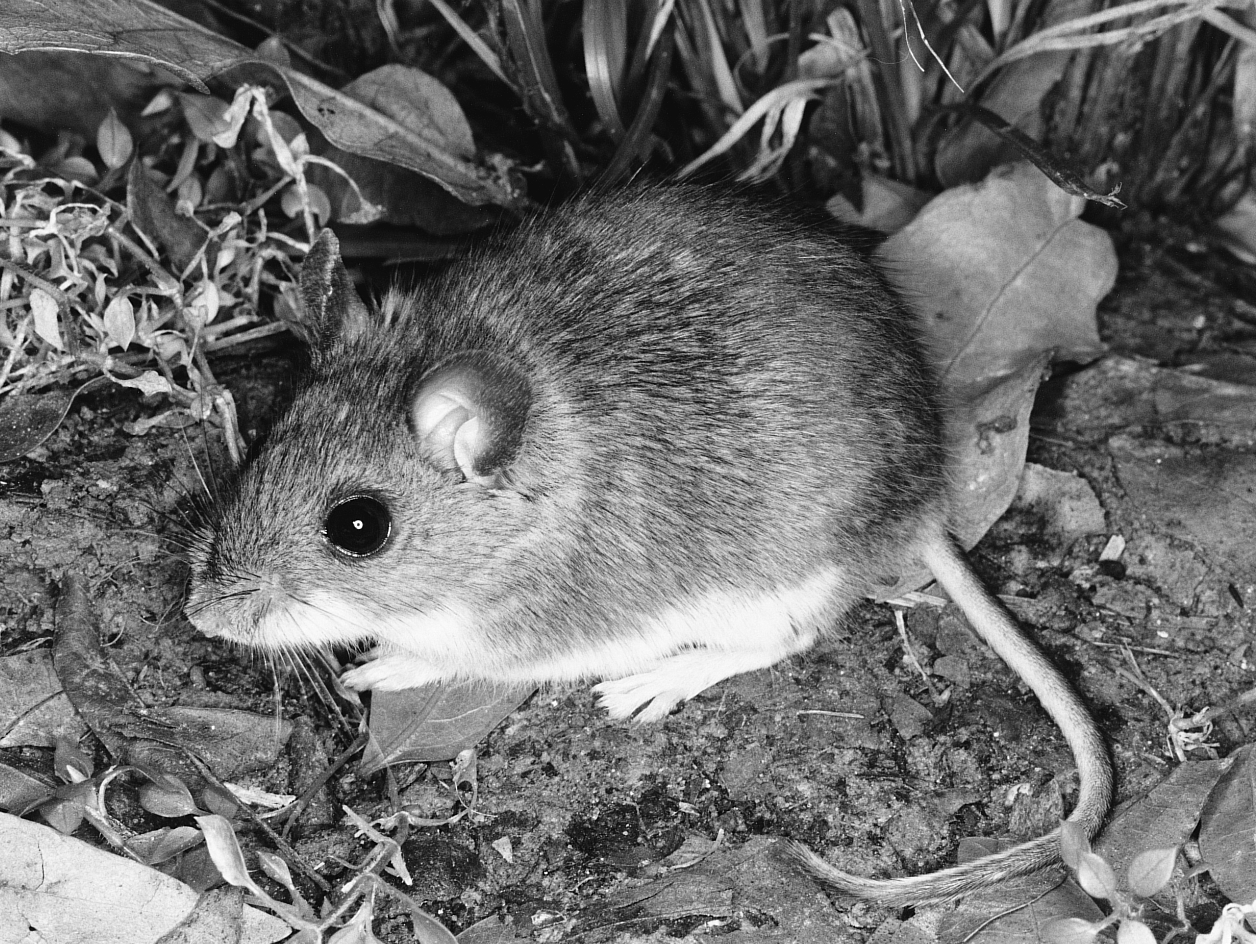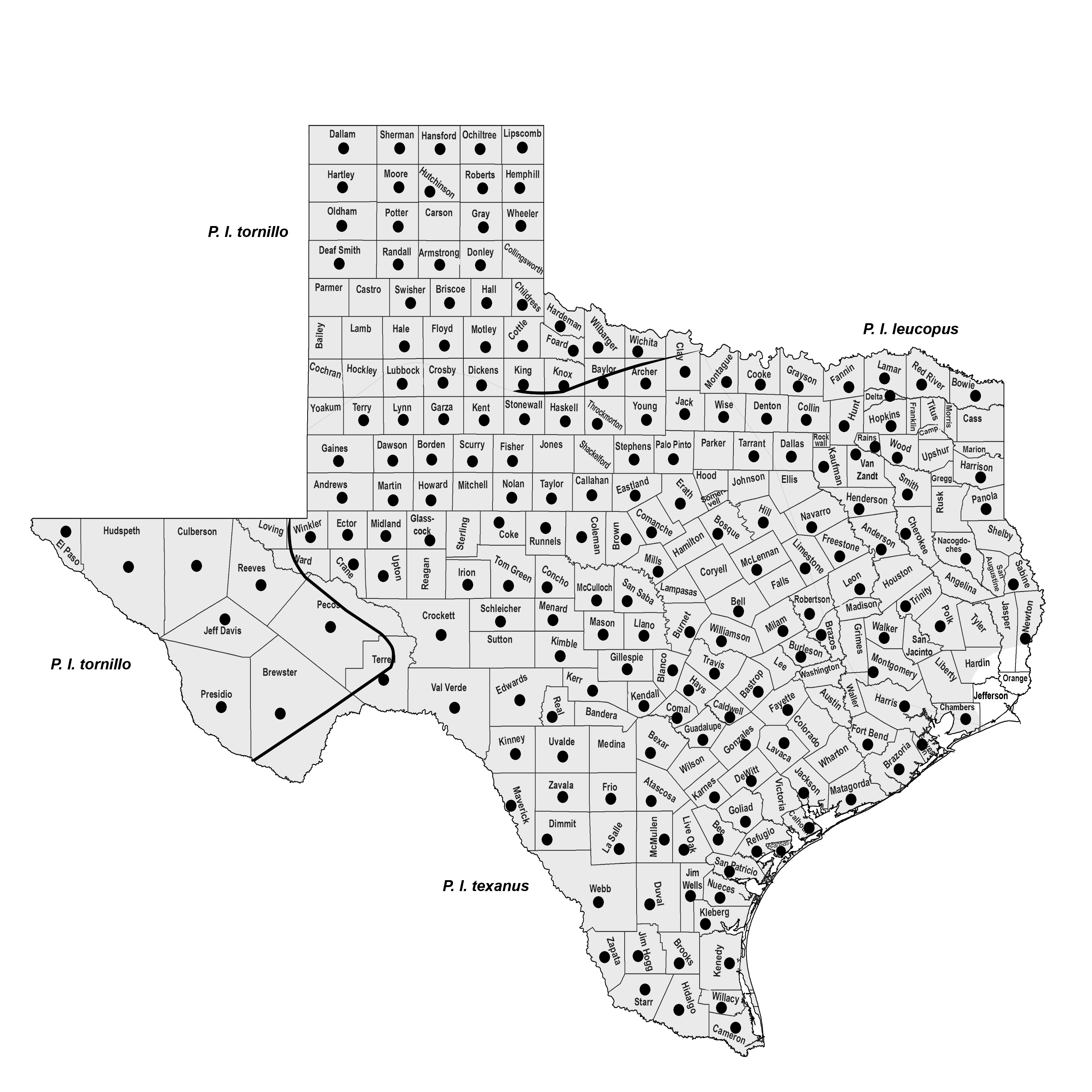WHITE-FOOTED DEERMOUSE
Peromyscus leucopus (Rafinesque 1818)
Order Rodentia : Family Cricetidae
DESCRIPTION. A medium-sized, short-tailed deermouse; tail about 43% of total length, sparsely haired, darker above than below but usually not sharply bicolor; upperparts cinnamon rufous mixed with blackish; sides paler, with less admixture of black; underparts and feet white, the ankle slightly brownish. Most easily confused with P. gossypinus and P. maniculatus. Peromyscus leucopus differs from the former in smaller size, shorter body, lighter weight, and brighter colors; from the latter in less hairy and not sharply bicolor tail, usually shorter pelage, and lack of whitish tufts at base of ears. Dental formula: I 1/1, C 0/0, Pm 0/0, M 3/3 × 2 = 16. Averages for external measurements: total length, 173 mm; tail, 78 mm; hind foot, 21 mm. Weight, 15–25 g, averaging about 22 g.

DISTRIBUTION. Statewide except for the northeastern coastal bend.

SUBSPECIES. Peromyscus l. leucopus in the eastern third of the state; P. l. texanus in central Texas westward to Brewster, Terrell, and Val Verde counties; and P. l. tornillo in the Panhandle and much of the Trans-Pecos. The subspecies are in need of taxonomic review.
HABITS. Normally, these deermice are woodland dwellers, a fact that is best illustrated along the western border of their range, where they are restricted almost entirely to creek and river bottoms. As one progresses eastward, the mice are found in a progressively greater variety of habitats. In east-central Texas, they are most abundant in bottomlands, less so in post oak uplands, and almost completely absent from prairie lands. On the Llano Estacado, the white-footed deermouse occupies a more catholic variety of habitats, occurring in brushy, weedy fencerows, mesquite grasslands, and near rocks and junipers on the escarpment. They are adept at climbing and often den in hollow trees out of danger from overflow waters. In areas not subject to inundation, they live in dens under logs, stumps, brush piles, burrows, or buildings.
In much of its range, this deermouse is one of the commonest of small mammals. In Brazos County, the population of this mouse is exceeded only by that of the hispid cotton rat. In 3,483 trap-nights, 161 hispid cotton rats and 121 white-footed deermice were captured. The maximum home range of adult males is about 0.2 ha, that of adult females about 0.15 ha (0.4 acres). The mice seldom travel >50 m (>165 ft.) once they are established in suitable quarters.
Peromyscus leucopus mostly is nocturnal, and it forages for seeds, mesquite beans, berries, fruits, nuts, and insects. In addition, carrion is sometimes consumed. A considerable amount of the foraging activity of the white-footed deermouse occurs in brushy vegetation. When food is abundant, they store it in and about their nests for winter use. Cache sizes of several liters have been reported. In spring and summer they feed to some extent on fruits and on insects, snails, and other invertebrates.
Available data suggest that breeding occurs year-round during favorable conditions, but that midwinter and midsummer are the least favorable reproductive periods. In east-central Texas, pregnant females have been captured in nearly every month of the year, and on the Llano Estacado pregnant females have been recorded for all months except February and July. Litter size varies from one to six, averaging about four, and multiple litters may be produced each year. Captive females have produced as many as 10 litters and 45 offspring in 1 year. The gestation period is 22–25 days in nonlactating females and 23–37 days in those that are lactating. At birth, the young are blind, pink, and weigh about 2 g. They become pigmented dorsally in the first 24 hours, their eyes open in about 13 days, and they are weaned at the age of 22–23 days if the mother is expecting a new family; otherwise, they may nurse as long as 37 days. Young females mature sexually at the age of 10–11 weeks and may bear their first litters at the age of 13–14 weeks. Usually, females born in the spring rear one or two litters themselves before winter sets in. They seldom live to be >18 months old in the wild.
Where numerous in an area, they can become destructive of stored grains and consequently need to be controlled. However, in most places they are of little or no economic significance if such natural predators as owls, snakes, and weasels are not removed from the ecosystem.
POPULATION STATUS. Common. The white-footed deermouse has a statewide distribution, and it is the most common and widespread of all the species of Peromyscus in Texas.
CONSERVATION STATUS. The IUCN lists the white-footed deermouse as a species of least concern, and it does not appear on the federal or state lists of concerned species. There are no immediate threats, although local populations could succumb to land clearing associated with extensive development.
REMARKS. Given the somewhat peridomestic nature of these mice and the recent association with hantaviruses, this species should be handled with caution.
From The Mammals of Texas, Seventh Edition by David J. Schmidly and Robert D. Bradley, copyright © 1994, 2004, 2016. Courtesy of the University of Texas Press.
Natural Science Research Laboratory
-
Address
Museum of Texas Tech University, 3301 4th street, Lubbock, TX 79409 -
Phone
806.742.2486 -
Email
nsrl.museum@ttu.edu

